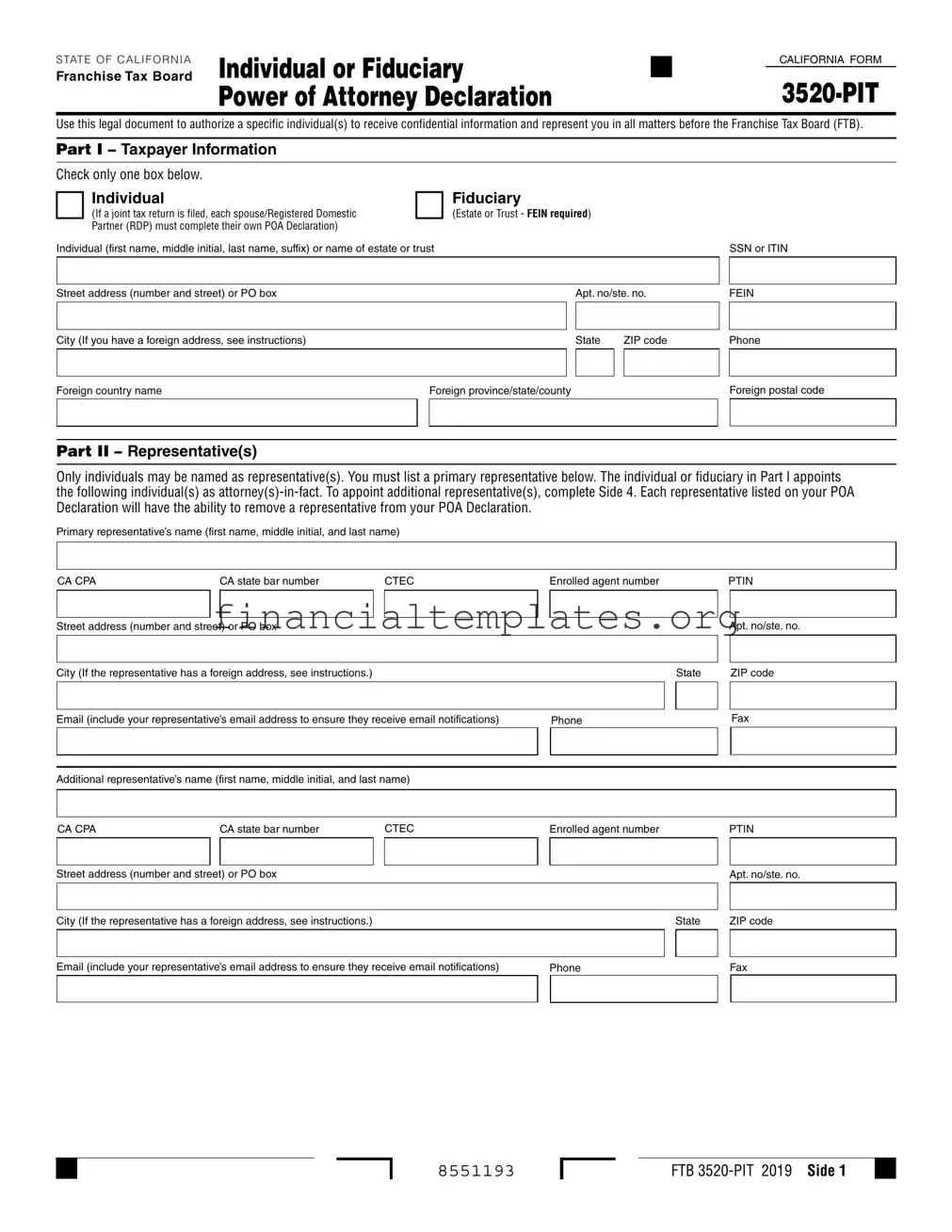The Tax Power of Attorney (POA) 3520-PIT form shares similarities with the IRS Form 2848, "Power of Attorney and Declaration of Representative." Both documents grant a designated individual the authority to represent the taxpayer before the IRS, allowing them to make inquiries, obtain confidential tax information, and perform specific acts like signing agreements. However, Form 2848 is more comprehensive in its application, covering federal tax matters beyond the state-specific matters addressed in the 3520-PIT form.
Another document akin to the Tax POA 3520-PIT is Form 8821, "Tax Information Authorization." This form also authorizes individuals to receive and inspect confidential tax information on behalf of someone else. However, unlike the 3520-PIT, Form 8821 does not allow the appointed person to represent the taxpayer in tax matters or perform any acts; it solely allows them to review the information.
The Durable Power of Attorney (DPOA) is similarly related to the Tax POA 3520-PIT but has a broader scope. DPOAs grant agents the power to handle a wide range of legal and financial matters for the principal, not just tax issues. This can include managing property, financial accounts, and even making life decisions, contrasting the specific tax representation focus of the 3520-PIT.
Form SS-4, "Application for Employer Identification Number (EIN)," is connected to the Tax POA 3520-PIT in the sense that both can involve third-party authorization. On Form SS-4, an entity applies for an EIN, and a third party can be authorized to receive the EIN and answer questions on behalf of the applicant, similar to how a Tax POA allows for representation in tax matters.
Form 4506-T, "Request for Transcript of Tax Return," is yet another document that, like the Tax POA 3520-PIT, involves authorization to obtain tax-related information. Both forms can authorize representatives to access tax transcripts, albeit Form 4506-T is specifically tailored for the purpose of requesting transcripts rather than broader tax representation.
The Health Insurance Portability and Accountability Act (HIPAA) Release Form, though not tax-related, parallels the Tax POA 3520-PIT in the concept of authorization. It allows designated individuals to access another's private health information, similar to how the Tax POA enables access to confidential tax information and representation.
The "Limited Power of Attorney," akin to the Tax POA 3520-PIT, grants an agent the authority to perform specific acts on behalf of the principal. However, while the Tax POA is narrowly focused on tax representation and actions, a Limited Power of Attorney can cover a wide range of specific, non-tax-related tasks.
The IRS Form 706, "United States Estate (and Generation-Skipping Transfer) Tax Return," connects to the Tax POA 3520-PIT because executors or legal representatives may need POA to manage tax filings and responsibilities for an estate, underscoring the role of representatives in handling complex tax matters following someone's death.
Form 709, "United States Gift (and Generation-Skipping Transfer) Tax Return," is related to the Tax POA 3520-PIT in context. Similar to estate tax filings, gift tax filings might require a POA for individuals to manage the filing on behalf of another, emphasizing the need for representation in intricate tax situations.
Lastly, the IRS Form 56, "Notice Concerning Fiduciary Relationship," has ties to the Tax POA 3520-PIT form as both address representation roles in tax matters. Form 56 is used to notify the IRS of a fiduciary relationship, requiring the fiduciary to file and act on behalf of another in tax matters, showcasing the legal framework for representation similar to what is established through a Tax POA.





